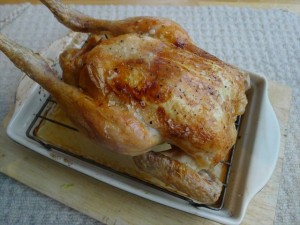 If you went in search of the ultimate roast chicken recipe, there’s every chance you could go mad en route.
If you went in search of the ultimate roast chicken recipe, there’s every chance you could go mad en route.
Everyone has an opinion and will spruik a different path to get to the gold.
Do you gently poach the chicken first to keep the breast moist? Rotate it like a Romanian gymnast every 20 minutes in the oven to get an even glow? Shove a lemon or a beer can up its wazoo for extra flavour? Add a compound butter over the breast? Shun all butter or liquids? (Liquids supposedly being the enemy of crisp skin.)
But sometimes golden perfection isn’t what you need. I don’t need a chicken that’s going to make angels misty eyed. I just want one that’s going to work and make happy to be home. And while I trust Mr Blumenthal on most matters, to be honest, it’s a rare day that I’ll have the forethought to brine a chicken 24 hours before I intend to roast it. Most often a craving for bird comes because I’ve had a flailing few hours and I want something to right the world again.
What I need is a recipe I can remember, so even if I’ve had three glasses of wine with lunch, or have just come off an international flight I can make it work.
I want I want crackly skin, not-too-dry breasts and to avoid any incidents of salmonella. I want something I can carve relatively easily and that will make the flat smell lovely while it cooks.
Then there are the others at the dinner table with opinions. The Hungry One is more of a breast than a leg man (god knows what he’s doing with me) – but gets a little squeamish if the skin on the undercarriage of the bird isn’t also bronzed- so that’s become a factor.
With all that in mind the below have become factors in determining my default roast chicken.
1) I want the majority of the time that it’s cooked for to be 180 C/350F. It’s a good moderate temperature. It’s also the temperature I cook most things off piste at. Roasting vegetables? Chuck them in the oven at 180C until they’re done. Same goes for fish. It’s not a temperature I forget easily.
2) I want it to have a trivet that can become the base of a sauce- or a side, or both. My current favourite is lardons and onions and garlic. When the chicken is doing its final blast in the oven and rest I transform them into a sauce/side with frozen peas and shredded gem lettuce. The trivet not only contributes wonderful smells to the flat (surely the founding point of a roast chicken) , but it’s also the modest beneficiary of juices that drip down from the bird.
3) I want something that I can have on the table in under 2 hours. If I’m home at 6 then dinner on the table at 8 is fine. Nine is pushing it. If we’ve got guests, if we haven’t got the main course on by 9pm, everyone’s too sozzled to care. We might as well have ordered pizza.
4) I want something that’s flexible enough to be a flavour tourist. If I fancy heading to Spain I can add chorizo to the trivet with onions and tomatoes and add smoked paprika to the butter under the breast. If it’s Italian then it’s oregano under in with the butter and cavalo nero instead of lettuce and peas. If it’s Asian I’m after I could add Chinese sausage to the base and garlic and chilli to the butter, substituting the peas and lettuce for Asian greens.
Beyond the flavourings, here are some tricks that help pull it off.
a) Buying a decent chicken. Seems obvious, but the more money you spend, probably the better it will taste. Free range is a must, organic preferable to me. Happy chickens taste better.
b) Have the chicken at room temperature before you put it in the oven. The timings will work better if it’s not fridge cold.
c) Make sure the chicken is dried well with paper towel before you put it in the oven.
d) Before you cook, gently separate the skin from the breasts with your fingers – if it’s too taut start by working your fingers up from the wing towards the centre. This allows you to insert the flavoured butter next to the breast – and also gives you access to the wishbone.
e) This here is the kicker- using a very sharp paring knife, take out the wish bone before you roast the bird. If your sole joy in life is pulling the wishbone from a roasted chicken, you possibly need to get out more. The benefit of removing the wishbone before roasting is that it will make it innumerably easier to carve it when it’s done. Much better to battle with the innards of a chicken on your own in the kitchen than to inadvertently hack to pieces a beautifully roasted bird in front of your hungry friends.
So here it is; my default roast chicken, with a side braise of lardons, lettuce and peas. Trust me on the lettuce, it has a gentle sweetness and a very forgiving texture. It’s lovely against the crisp skin. .
This serves two to four people, depending on how hungry everyone is and what else you’ve got on the table (a good baguette and butter wouldn’t go astray).
I serve it with Dijon mustard and a large glass of wine. It makes me feel grounded- in exactly the same sort of way as knowing I’ve now got a default roast recipe for life.
Default roast chicken (with bacon, lettuce and peas)
Equipment
Paper towel. 1 sharp knife. 1 roasting tray. 1 roasting rack. 1 Dutch oven.
Shopping/foraging
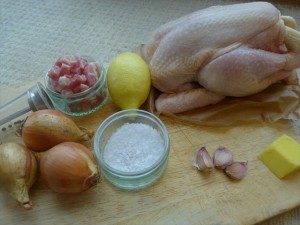 1.3 kilogram organic, free range, very happy chicken
1.3 kilogram organic, free range, very happy chicken
1 tablespoon of butter
Zest of half a lemon
90 grams of lardons/smoked bacon finely chopped
3 small-medium brown onions, cut into .5 cm half moons
3 garlic cloves, finely sliced or crushed
1 tablespoon of salt flakes
1 teaspoon of ground black pepper
For the peas and lettuce accompaniment
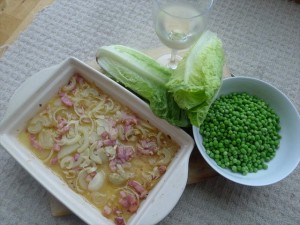 2 cups of frozen peas
2 cups of frozen peas
2 gem lettuces, cored and shredded very finely
1/2 cup of white wine
Roasted onions, garlic and lardons from the bottom of a roast chicken
Here’s how we roll
1) Preheat oven to 180 C/350 F.
2) Let the chicken come to room temperature, out of plastic.
3) Remove any giblets or stray sad bits from inside the bird (including extra deposits of fat). Pat dry with paper towel.
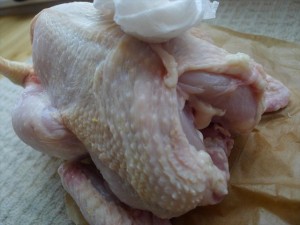 4) Carefully separate the skin from the breast with your fingertips. Pull back the skin over the breast a little to expose the wish bone. Using the tip of a sharp knife trace around the outside of the bone and nick at the top and bottom to separate it. Use your fingers to prise it away from the flesh. If it breaks, that’s ok, just make sure you’ve got the v shaped join at the top.
4) Carefully separate the skin from the breast with your fingertips. Pull back the skin over the breast a little to expose the wish bone. Using the tip of a sharp knife trace around the outside of the bone and nick at the top and bottom to separate it. Use your fingers to prise it away from the flesh. If it breaks, that’s ok, just make sure you’ve got the v shaped join at the top.
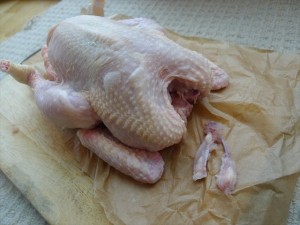 5) Make the compound butter by combining the lemon zest with the butter.
5) Make the compound butter by combining the lemon zest with the butter.
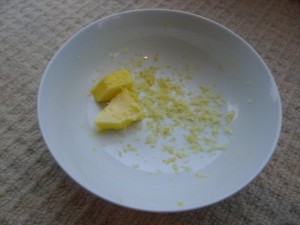 6) Insert the butter under the skin of the breast and encourage it along the breast.
6) Insert the butter under the skin of the breast and encourage it along the breast.
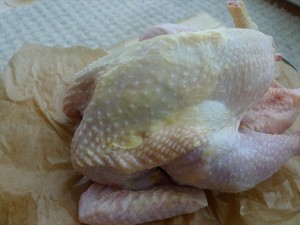 7) Line the bottom of the baking tray with the lardons, garlic cloves and onions slices.
7) Line the bottom of the baking tray with the lardons, garlic cloves and onions slices.
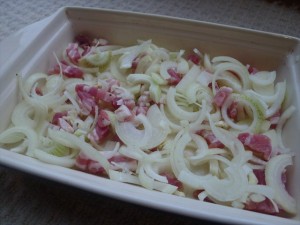 8 ) Place a roasting rack above the onion and bacon trivet. Lay the chicken breast side down on the roasting tray. Season the underside of the chicken generously with salt and pepper.
8 ) Place a roasting rack above the onion and bacon trivet. Lay the chicken breast side down on the roasting tray. Season the underside of the chicken generously with salt and pepper.
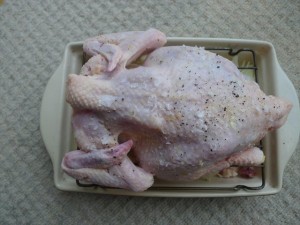 9) Place the chicken in the oven at 180C/350F for 1 hour.
9) Place the chicken in the oven at 180C/350F for 1 hour.
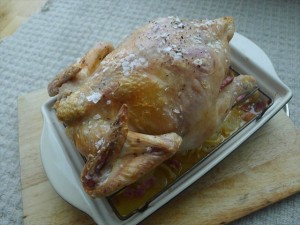 10) After one hour remove the chicken and turn the oven up to 230C/445 F.
10) After one hour remove the chicken and turn the oven up to 230C/445 F.
11) Transfer the trivet and all the chicken juices to a saucepan or dutch oven large enough to take the onion, bacon, lettuce and peas.
12) Gently rotate the chicken on the roasting rack so it now sits breast side up and season well with salt and pepper.
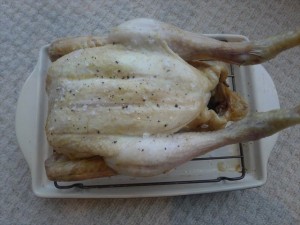 13) When the oven hits 230 C/ 425 F return the chicken to the oven and bake for 20 minutes to ensure a good colour on the breast.
13) When the oven hits 230 C/ 425 F return the chicken to the oven and bake for 20 minutes to ensure a good colour on the breast.
14) Turn the dutch oven or fry pan with the onion and bacon onto high and fry to ensure that all the fat on the bacon has rendered.
15) Add the peas and the lettuce and the wine and braise on a medium heat until the lettuce has wilted and the peas are defrosted and cooked.
16) After 20 minutes take the chicken out of the oven and check that the juices from the thickest part of the thigh run clear. Allow the chicken to rest for 15 minutes before carving.
17) To carve the chicken keep the chicken breast side up. Cleave the legs from the breast by pulling the leg outwards (from 6 o clock to 3 o clock on the right side and from 6 o clock to 9 o clock on the left). Then using a sharp knife cut through the ball and socket joint and put the legs to the side.
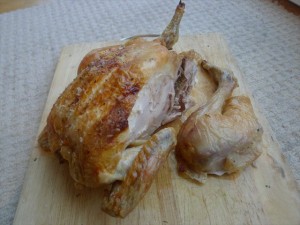 18) To cut the breast cut straight down the centre, from neck to the bottom. Now angle your knife at 45 degrees and cut the breast outwards off the carcass. Place it on a chopping board and cut it horizontally into medallion slices. Do the same thing on the other side. Then cut off the wings and turn the chicken over to make sure you grab hold of the ‘oysters’ – the best tasting part of the chicken. Set the chicken carcass aside to make stock with.
18) To cut the breast cut straight down the centre, from neck to the bottom. Now angle your knife at 45 degrees and cut the breast outwards off the carcass. Place it on a chopping board and cut it horizontally into medallion slices. Do the same thing on the other side. Then cut off the wings and turn the chicken over to make sure you grab hold of the ‘oysters’ – the best tasting part of the chicken. Set the chicken carcass aside to make stock with.
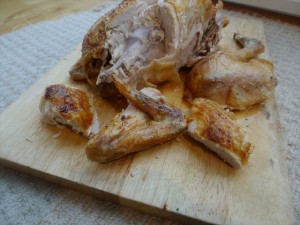 19) Serve the chicken pieces over the peas and lettuce with a dab of Dijon mustard and some green herbs.
19) Serve the chicken pieces over the peas and lettuce with a dab of Dijon mustard and some green herbs.
In the spirit of sharing, what’s your default roast chicken?

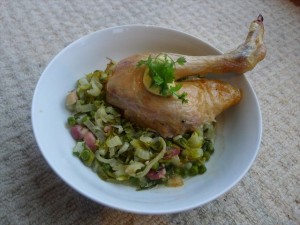

That looks completely delicious! I have to make dinner now.
I shove mine in the oven at 180 C. Sometimes I rub some butter over the skin (not under). Just plain old butter. At some point, some spuds go in, in another tray, often with chicken fat left over from the last roast, or goose fat if I have some. Sometimes I even bother with green vegetables to go with. But not always.
Gravy is generally Bisto with pan juices and port added to it.
I AM the lazy cook.
After, I do pick every last bit of meat off the carcass and throw the carcass / tendons / skin into the slow cooker overnight to make stock. Next night is most commonly risotto.
Sometimes chicken croquettes or other goodies made from leftover roast chicken. I love leftover roast chicken.
Love the title of a default roast chicken. I love a good roast chicken and even better is leftover roast chicken and making stock from the bones. It’s the meal that just keeps on giving.
Oh lovely, I’ve never roasted a chicken before and this recipe looks quite great
Roast chicken makes an appearance in the O’Toole house every couple of weeks, and is always happily received. I look forward to trying your default recipe- looks delicious!
I laughed out loud when I read this: “The Hungry One is more of a breast than a leg man (god knows what he’s doing with me)” Great. I LOVE your writing haha. 🙂
Also thanks for this recipe, I’ll keep it tucked away for when I’m brave enough to roast a whole chicken. Hopefully that will be soon!
Gorgeous, might have to do your roast chook on sunday. Chicken always seems to be the favourite in my house, with lashings of red wine. Normally roast the spuds in the same pan with the chicken juices. Freezer is currently bulging with stock, risotto or oriental noodly soups normally follow a roast. Tarragon and leftover chicken being my current fave. Love your recipe!
Help! We’re in the middle of making this – when to add the white wine? (About to neck it in a panic!) But thinking with the greens, or earlier?
Argh- am so sorry- the wine is added in with the peas and the lettuce in the braise- it’s not essential though, just a little bit more liquid and another layer of flavour. Have altered the recipe to show. If you haven’t, then then neck it heartily.
My husband is more of a breast person than a leg person… at the beginning this really disappointed me but now I consider myself lucky… More legs and wings for me, although I do have two little hungry ones to contend with now too…
I have read all those roast chicken recipes you mentioned and have my own favorite way to make it but a few of your tips were new to me and sound interesting… the wishbone, starting the roasting breast side down… will keep them in mind.